Mineral Inclusions in Sapphire from Basaltic Terranes in Southern Vietnam: Indicator of Formation Model

ABSTRACT
Sapphires in southern Vietnam have been discovered in alluvial gem fields derived from Cenozoic basalts. Several syngenetic mineral inclusions were identified by Raman spectroscopy and electron probe microanalysis; they were classified as ferrocolumbite, zircon, alkali feldspar (albite-anorthoclase-oligoclase), pyrochlore, hercynite spinel, and ilmenite (titanohematite series). Geochemical characteristics of these inclusions appear to have evolved from an alkaline felsic suite. Consequently, the original formation of these sapphires would be related to alkaline felsic magmatic processes before basaltic magmatism, which was derived from the deeper upper mantle, had passed through and transported the sapphires and their associated minerals to the surface via volcanic eruption.
INTRODUCTION
Since the late 1980s, sapphire mines in southern Vietnam have supplied significant quantities of gem materials to the jewelry industry (figure 1). Commercial gem mines in southern Vietnam have been located in four main areas, including Dak Nong, Di Linh, Binh Thuan, and Krong Nang (figure 2) (Smith et al., 1995; Long et al., 2004; Garnier et al., 2005; Izokh et al., 2010; Vu, 2010, 2018). Specifically, the first discovery of abundant gem sapphires was in Dak Nong, followed by Di Linh, Binh Thuan, and Krong Nang, respectively. These sapphires accumulated in Upper-Pleistocene to Quaternary alluvial deposits.
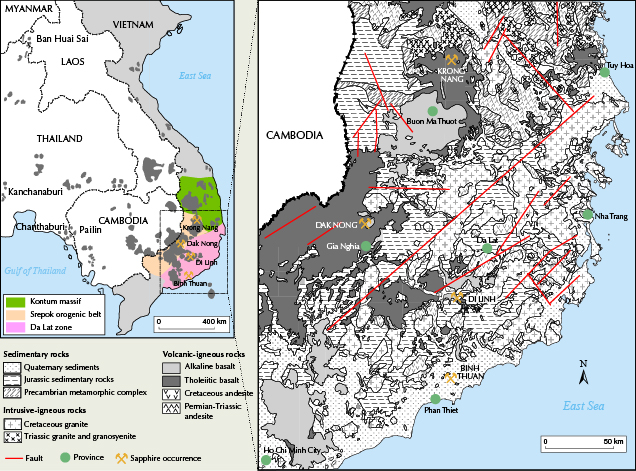
In 2017, we carried out field trips in southern Vietnam encompassing Binh Thuan Province, Di Linh (Lam Dong Province), Dak Nong Province, and Krong Nang (Dak Lak Province), where sapphire samples were collected directly from the mines (see figure 2). Gem mining activities in these areas are conducted by a few local miners. Pits are dug with basic tools before washing and hand picking along streams by artisanal miners (figure 3), and mines worked by machinery (figure 4) can also be found. Sapphires in this region usually range from dark blue to bluish green, yellowish green to green, with rare yellow sapphire. The natural intense blue sapphire is the best known and has been specifically recovered from the Dak Nong and Di Linh gem fields (figure 1, left). Other colors such as bluish green and yellowish green to green are common, particularly in the Binh Thuan and Krong Nang gem fields, respectively (figure 1, right). However, these sapphire varieties are generally heat treated for color enhancement. In addition, trapiche-type sapphires (figure 5) are sometimes found in these gem fields.
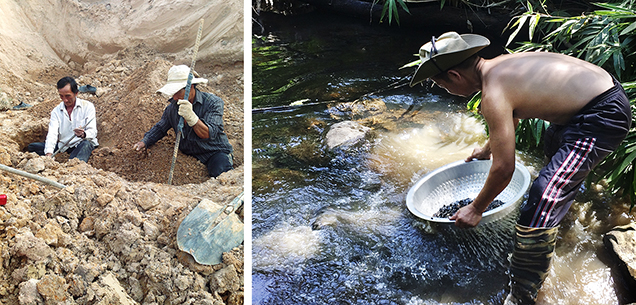
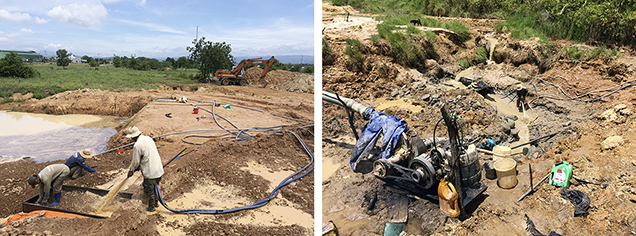
Gemological properties and chemical fingerprints of sapphire from southern Vietnam have identified this material as basaltic-type (Smith et al., 1995; Long et al., 2004; Garnier et al., 2005; Izokh et al., 2010; Vu, 2010, 2018). However, understanding of their formation remains unresolved. Inclusions in sapphire, including basaltic type, have become a highly interesting issue in the last decade. These inclusions may preserve significant information on chemical and physical conditions directly related to the original formation of the basaltic-type sapphire. Subsequently, various analytical techniques such as Raman spectroscopy, scanning electron microscopy with energy-dispersive spectroscopy (SEM-EDS), and electron probe microanalysis (EPMA) have been applied for identification of inclusions in sapphire from southern Vietnam. For example, Smith et al. (1995) and Long et al. (2004) used SEM-EDS to identify various mineral inclusions in sapphires from Dak Nong and Phan Thiet, whereas Izokh et al. (2010) applied EPMA for chemical analyses of a few inclusions in sapphires from Dak Nong.
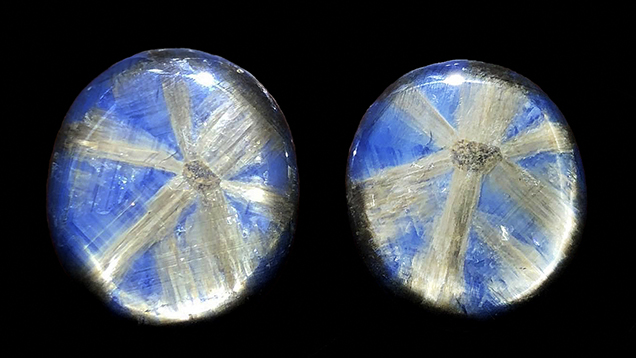
Although a variety of mineral inclusions in sapphires from southern Vietnam were previously reported, the chemistry of these inclusions has not been widely analyzed. Therefore, this study is focused on a wider variety of mineral inclusions and their chemical analyses using EPMA. These analytical data lead to a reconstruction of a genetic model of sapphire formation related to basaltic volcanism in this region. They also yield significant information for origin determination by gem testing laboratories.
GEOLOGICAL SETTING
Southern Vietnam geologically belongs to a large-scale structure of the Da Lat active continental margin (Da Lat zone) and the Indosinian polyepisodic orogenic belt (Srepok orogenic belt) (figure 2, left) (Tri and Khuc, 2011), which separated from Gondwana in the Devonian (Şengör et al., 1988; Hutchison, 1989; Metcalfe, 1988, 1996, 2009, 2011). Rock formations range widely: Precambrian basement rocks, Jurassic sedimentary rocks, late Mesozoic igneous rocks, and Cenozoic basaltic rocks (Hoa et al., 2005) (figure 2, right). The basement rocks in this area are composed of metamorphic complexes of granulites and gneiss granulite. A thick pile of Jurassic rocks covering the basement rocks is composed of sandstone, siltstone, and shale. These basement rocks and Jurassic rocks are intruded by a number of late Mesozoic rocks, including Triassic granite and granosyenite and Cretaceous granite.
The uppermost part of the area was eventually covered by Cenozoic basalts, which are directly associated with sapphires in southern Vietnam. These Cenozoic (Neogene-Quaternary) basalts range in age from 0.8 to 17.6 Ma (Hoang and Flower, 1998; Garnier et al., 2005) and appear to have been related to the most recent tectonic event, the opening of the East Sea after the Indian-Eurasian collision (from 35 to 17 Ma) (Barr and MacDonald, 1981; Rangin et al., 1995; Hoang and Flower, 1998; Lee et al., 1998). According to Hoang and Flower (1998), these basalts covering an area of about 23,000 km2 with a thickness of several hundred meters erupted in two main episodes. The early stages mostly included tholeiite basalts, which erupted from extensional fissures trending along the NE-SW and NW-SE directions, derived from the lithosphere. On the other hand, the latter alkali basalts usually flowed along conjugate strike-slip faults originating from the asthenosphere. Only the alkali basalts in particular are associated with sapphire (Smith et al., 1995; Garnier et al., 2005; Izokh et al., 2010). According to Garnier et al. (2005), alkali basalts in Dak Nong are characterized by porphyritic olivine basalts that comprise olivine, clinopyroxene, plagioclase, and spinel. These compositions are associated with megacrysts, xenocrysts, and xenoliths of the mantle and lower crust. Mantle xenoliths embedded in Dak Nong basalts are recognized as garnet lherzolite and spinel lherzolite, while xenocrysts include olivine, Al-rich clinopyroxene, orthopyroxene, phlogopite, sapphire, and zircon. Lower crustal xenoliths usually contain plagioclase and quartz. The presence of mantle xenoliths, xenocrysts, and lower crustal xenoliths may indicate that crystallization of these minerals occurred at high pressure in a magma chamber close to the boundary between the upper mantle and lower crust.
MATERIALS AND METHODS
Over a thousand unheated, gem-quality rough sapphires were collected directly from the gem fields in southern Vietnam (Dak Nong, Di Linh, Krong Nang, and Binh Thuan) for this study. Most of the samples from the Dak Nong and Di Linh mines were collected by the first author over 20 years, while sapphires from Binh Thuan and Krong Nang were collected in 2001 and 2012, respectively. Moreover, more samples from all areas were collected by the authors during the field trip in 2017. These were initially investigated under a gemological microscope to find suitable samples containing mineral inclusions. Subsequently, a total of 274 sapphire samples (77 from Dak Nong, 75 from Di Linh, 45 from Krong Nang, and 77 from Binh Thuan) were then selected and polished to expose the inclusions.
These inclusions were then identified by a Renishaw InVia 1000 laser Raman spectroscope at the Gem and Jewellery Institute of Thailand (Public Organization) (GIT). Subsequently, they were analyzed for major and minor compositions using a JEOL JXA-8100 electron probe microanalyzer at the Department of Geology, Faculty of Science, Chulalongkorn University. Operating conditions were set at 15 kV acceleration voltage and 24 nA filament current with 30 seconds of peak and background counts for each element prior to automatic ZAF calculation and reporting in oxide forms. The general detection limits of major and minor analyses obtained from EPMA are typically lower than 0.01 oxide wt.%. Various natural minerals and artificial standards were used for calibration. These included quartz, corundum, eskolaite, fayalite, manganosite, periclase, nickel oxide, wollastonite, jadeite, potassium titanium phosphate, strontium barium niobate, zirconium, yttrium phosphate, cerium phosphate, and neodymium phosphate for SiO2, Al2O3, Cr2O3, FeO, MnO, MgO, NiO, CaO, Na2O, K2O, Nb2O5, ZrO2, Y2O3, Ce2O3, and Nd2O3, respectively. Fe2+ and Fe3+ ratios of some specific minerals (e.g., spinel and ilmenite) were estimated by stoichiometric calculation as suggested by Droop (1987). Additionally, a total of four samples that contained zircon inclusions, one from each area, were analyzed for their rare earth elements (REE). These were analyzed using an Agilent 7700 quadrupole ICP-MS instrument, attached to a Photon Machines Excimer 193 nm laser ablation (LA) system at Macquarie University in Sydney, Australia. The analyses were carried out using the same laser conditions as for U-Pb dating. Detailed descriptions of analytical and calibration procedures were given by Belousova et al. (2002). These zircon inclusions were analyzed using a 2 Hz pulse rate with about 0.5 mJ beam energy per pulse, achieving a spatial resolution of about 30 μm. Quantitative results for the trace elements reported here were obtained through calibration of relative element sensitivities using NIST-610 standard glass as the external calibration standard. The BCR-2g and zircon 91500 and GJ-1 reference materials were analyzed within the run as an independent control on reproducibility and instrument stability. Zr content was used for internal calibration for unknown zircon samples (66 wt.% of ZrO2 as the stoichiometric amount of this oxide in zircon). The precision and accuracy of the NIST-610 analyses were determined to be 1–2% for rare earth elements at the ppm concentration level. Typical detection limits (99% confidence) are provided in table 4.
RESULTS
The most common internal feature of sapphire from southern Vietnam was strong color zoning (figure 6A). Other features included parallel twin planes, needle-like inclusions (figure 6B), liquid-filled inclusions (figure 6C), and negative crystals (figure 6D). Based on Raman spectroscopic and EPMA analyses, 290 mineral inclusions were identified; they were mainly Nb-Ta oxides, followed by silicate and other oxide minerals. The types of mineral inclusions in each sample group are summarized in table 1. Mineral inclusions previously reported in sapphires from Thailand, Laos, and Cambodia are also compared in the same table. Columbite and zircon were the most common inclusions in these sapphire samples, while alkali feldspar and spinel were often identified. Ilmenite, pyrochlore, and unidentified iron minerals were rarely detected. Details of these inclusions are provided below.
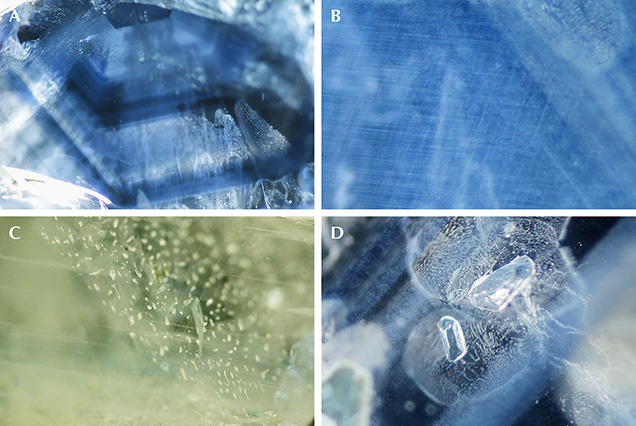

Columbite was the predominant mineral inclusion observed in sapphires from all gem fields in southern Vietnam, accounting for nearly 47% of the 290 mineral inclusions contained in the 274 samples. They generally formed as opaque black euhedral crystals with a rhombic prism with pyramidal shape and a truncated rhombic pyramid shape, ranging in sizes from <10 μm up to several millimeters (figure 7, A and B). They were often associated with zircon, with or without feldspar (figures 7C and 9B). Representative EPMA analyses of columbite inclusions ranged between 65–77 wt.% Nb2O5, ≤4.5 wt.% Ta2O5, ≤12 wt.% TiO2, ≤3 wt.% MgO, 12–21 wt.% FeO, and <15 wt.% MnO (table 2); The chemical formula of these columbite inclusions can be expressed as (Fe0.373Mn0.133Mg0.133Ca0.228Ti0.091)(Nb0.938Ta0.010U0.001Zr0.007)2O6, which fits very well within the compositional range of ferrocolumbite (figure 8). Their compositions were also equivalent to those previously reported for sapphires from Dak Nong by Izokh et al. (2010) as well as from Lava Plains and New England in Australia (Guo et al., 1996; Sutherland et al., 1998b). Lower FeO contents of columbite inclusions in Bo Welu sapphire from Chanthaburi, Thailand, were reported by Promwongnan and Sutthirat (2019). Ferrocolumbite inclusions in sapphire from southern Vietnam contained low Ta content, yielding a Ta/(Ta+Nb) ratio < 0.05 within a wide range of Mn contents (<15 wt.% MnO and Mn/(Mn+Fe) ratio <0.5) (figure 8), which may have derived from peralkaline complexes (peralkaline granite/syenite) (Mackay and Simandl, 2015).



Zircon was the second most abundant inclusion, representing about 22% of the mineral inclusions contained in the sapphire samples. These inclusions commonly formed as euhedral tetragonal prismatic or dipyramidal crystals (figure 9, A and B). Most of the zircons were colorless, but some had orange to orange-red colors. Their chemical compositions varied within narrow ranges of approximately 31–34 wt.% SiO2 and 61–65 wt.% ZrO2 (table 3). The hafnium contents showed a slightly wider range of about 1–4 wt.%, leading to Hf/Zr ratios of 0.01 to 0.04, which fall in the range of magmatic zircon, particularly syenite and granite zircons (Deer et al., 2013). Significant trace elements included <1.5 wt.% ThO2, <1.8 wt.% UO2, and <0.6 wt.% Y2O3; these elements appeared to be higher in zircon inclusions of Di Linh sapphire. On the other hand, these zircon inclusions yielded Th/U ratios >0.2, indicating a magmatic source (Williams and Claesson, 1987; Rubatto and Gebauer, 2000; Huong et al., 2016). These were similar in composition to zircon analyses previously reported from Dak Nong (Izokh et al., 2010) and other basalt-associated sources such as Ban Huai Sai in Laos, Kanchanaburi in Thailand, and Kings Plains and New England in Australia (Guo et al., 1996; Sutherland et al., 1998a; 2002; Khamloet et al., 2014), although the Y2O3 content of zircon inclusions from Bo Welu in Thailand (Promwongnan and Sutthirat, 2019) has recently been reported with a higher content. Total REE contents of representative zircon inclusions ranged from 1156 to 2710 ppm (table 4), more similar to those from syenite pegmatite (2043 ppm) and granitoid (1813 ppm) than those from carbonatite (600–700 ppm) (Belousova et al., 2002).



Alkali feldspar inclusions were sometimes observed in the sapphire samples, making up about 13% of the mineral inclusions. They generally presented subhedral or euhedral grains with small sizes ranging from about 40 μm, with some rare examples reaching 1 mm. These included crystals were commonly transparent and colorless (figures 7C and 9C). Their chemical compositions were rather uniformly toward Na-rich feldspar between albite-anorthoclase-oligoclase (Ab77–98An<15Or1–11, see table 5 and figure 10). However, feldspar in Krong Nang sapphires mostly plotted close to the junction of albite-anorthoclase-oligoclase compositions (Ab82–86An6–11Or6–11), whereas Di Linh feldspar was divided into two groups: the first group close to the albite-anorthoclase boundary (Ab82–85An6–9Or8–11) and the second one containing lower K content near the albite-oligoclase boundary (Ab85–87An7–11Or4–5). Binh Thuan feldspar ranged between albite and oligoclase compositions, while most Dak Nong feldspar fell within albite composition (Ab83–98An1–10Or1–8). These compositional ranges were wider than those previously reported, as only oligoclase was identified in sapphires from Dak Nong (Izokh et al., 2010) and from Ban Huai Sai in Laos (Sutherland et al., 2002), but An and Or components were narrower in range than those in Thai sapphires from Kanchanaburi (An9–23Or6–14) (Khamloet et al., 2014) and Chanthaburi (An<14Or7–17) (Promwongnan and Sutthirat, 2019) and Australian sapphires from Kings Plains (An<14Or7–17) (Guo et al., 1996) and New England (An<53Or22–94) (Sutherland et al., 1998a).


Spinel inclusions accounted for about 4% of the mineral inclusions contained in the samples from southern Vietnam. They usually occurred as black cubic crystals (figure 11A). Spinel inclusions with compositions ranging between chromite-hercynite and magnetite-hercynite have been previously reported, on the basis of SEM-EDS analyses, in sapphires from Binh Thuan and Di Linh (Smith et al., 1995). However, EPMA analyses of spinel inclusions in this study revealed significant components of hercynite (FeAl2O4, Hc78–100) and spinel (MgAl2O4, Sp<23), whereas other components were negligible (table 6). The spinel inclusions’ Mg:Fe2+ ratios were mostly less than 1:4, falling into hercynite spinel (Deer et al., 2013). In comparison, these hercynite spinel inclusions contained a moderately lower spinel composition than those in sapphires from Pailin in Cambodia or from New England in Australia, but nearly the same as those from Kanchanaburi in Thailand (see also table 6).


Ilmenite (FeTiO3) was found in only two samples from Di Linh and one sample from Dak Nong. These inclusions were black, opaque, and euhedral (figure 11B), and their identity was confirmed by Raman spectroscopic identification. A previous study, based on SEM-EDS analysis, also recognized ilmenite in sapphires from Di Linh and Binh Thuan (Smith et al., 1995). The chemical composition of the ilmenite inclusions in this study clearly belonged to the titanohematite series (ilmenite-hematite, Il54–49He40–34) (table 7). The low Mn content (<0.15 wt.% MnO) of these titanohematites was closer to that from an igneous magma source (Lindsley, 1991) as reported from Sybille Monzosyenite (Fuhrman et al., 1988), and different from ilmenite with higher Mn originating from metamorphic rocks from Western Australia (Cassidy et al., 1988). Moreover, their Mn contents were similar to those of ilmenite in New England sapphires originating from silicate melt (Sutherland et al., 1998a) and different from those of ilmenite in Kanchanaburi sapphires from melt involved by subsequent contact metamorphism (Khamloet et al., 2014) (table 7).

Unidentified iron-bearing minerals were also observed in these sapphire samples. They presented as tiny black cubic crystals (less than 10 μm and a few around 30 μm) (figure 12A) with morphological forms similar to those identified for spinel inclusions. They were commonly associated with spinel inclusions and sometimes formed as composite inclusions (figure 12B). These iron-rich minerals contained up to 96% FeO and had aluminum contents ranging from 0.1 to 13% Al2O3 (table 8) and their Raman spectra indicated the presence of magnetite, with characteristic bands at 663 to 652 cm–1 (Faria et al., 1997). However, their atomic proportions, based on stoichiometric calculation as suggested by Droop (1987), yielded a ΣR3+/ΣR2+ ratio of almost 1:1, particularly Fe3+/Fe2+ (see table 8), which was inconsistent with the formula of magnetite (Fe3O4), with an Fe3+/Fe2+ ratio of 2:1. More details of these inclusions need to be worked out in the future.


Pyrochlore was recognized as an inclusion in three sapphire samples from Dak Nong and a couple of samples from Krong Nang. They formed similarly red cubic crystals, which were commonly surrounded by radial cracks (figure 13). Based on SEM-EDS analysis, Smith et al. (1995) previously reported uranpyrochlore, (Ca,U)2(Ti, Nb, Ta)2O6, in sapphires from Di Linh and Binh Thuan. EPMA analyses of pyrochlore in this study yielded a high U content (about 19–22% in ΣR2+), a high Nb content leading to a Nb/Ta ratio ≥ 8, and a (Nb+Ta)/Ti ratio of about 2 (table 9), all within the compositional range of uranpyrochlore (Hogarth, 1977). These compositions were similar to those found in Australian sapphires from Anakie (Guo et al., 1996) and New England (Sutherland et al., 1998a).
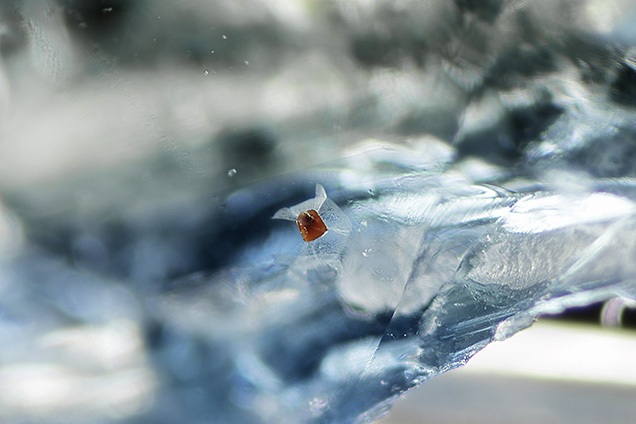

DISCUSSION
It has been suggested that sapphire and ruby deposited within basaltic terranes could not have crystallized directly from basaltic magma (Coenraads, 1992; Levinson and Cook, 1994; Guo et al., 1996; Sutherland et al., 1998a, 2002, 2015; Khamloet et al., 2014; Promwongnan and Sutthirat, 2019). A corroded surface is a typical feature observed in basalt-associated sapphires, clearly indicating transport by the hot magma. This has also been reported for sapphires from Di Linh and Binh Thuan (Smith et al., 1995). A petrochemical study of sapphire-associated basalts from Dak Nong has also suggested that these xenocrystic sapphires may have formed in the boundary between the lower crust and upper mantle prior to corrosive transport in alkali basaltic magma (Garnier et al., 2005). Moreover, a hypothesis has recently been proposed that the original crystallization of alluvial Dak Nong sapphires would have taken place in the shallow crust within an iron-rich syenite melt in collaboration with carbonate-H2O-CO2 fluid phases, based on the geochemistry of syngenetic mineral inclusions (i.e., zircon, columbite, oligoclase, and Al-Ti-hematite) (Izokh et al., 2010).
Based on the results of this detailed study, the most common syngenetic mineral inclusions (ferrocolumbite, alkali feldspar, and zircon) were similar in composition to those in Dak Nong sapphires (Izokh et al., 2010) as well as alkaline felsic inclusion groups in other alluvial basalt-related sapphires (Guo et al., 1996). Although hercynite spinel and ilmenite (titanohematite) inclusions observed in this study were quite different from Al-Ti-hematite in Dak Nong sapphires (containing 85.6 wt.% Fe2O3, 11.9 wt.% Al2O3, and 1.57 wt.% TiO2 as reported by Izokh et al., 2010), they still favored igneous sources instead of metamorphic sources. Although columbite and pyrochlore in the studied sapphires were chemically close to the inclusions Guo et al. (1996) proposed as representing a carbonatite assemblage, they were also similar to those found in alluvial basalt-associated sapphires from silicate melt origin (Sutherland et al., 1998a). Therefore, both columbite and pyrochlore may relate to silicate melts to indicate the original source of these sapphires.
Consequently, a unique mineral inclusion suite including alkali feldspar, zircon, hercynitic spinel, and ilmenite appears to have crystallized from alkaline felsic magma, which is relevant to the original source of sapphires from southern Vietnam. This magmatism should have taken place extensively prior to fractionated crystallization in the lower crust. This model agrees well with the genetic model proposed by Aspen et al. (1990), Sutherland et al. (1998a, 2009), Pin et al. (2006), Zaw et al. (2006), Upton et al. (2009), Khamloet et al. (2014), and Promwongnan and Sutthirat (2019).
Based on the geological setting in southern Vietnam, granite and granosyenite occurred in the Triassic and Cretaceous during orogenic periods due to Indosinian-Yangtze (South China) collision and Paleo-Pacific plate subduction, respectively (Carter et al., 2001; Nguyen et al., 2004; Tri and Khuc, 2011; Shellnutt et al., 2013). Subsequently, alkali basaltic magmas in southern Vietnam had probably been derived from garnet peridotite of the asthenosphere at high pressure (<4 GPa) and high temperature (about 1470°C) (Hoang and Flower, 1998), and mixed with recycling oceanic crustal materials from Paleo-Pacific plates that subducted beneath the Southeast Asian continental margin (Anh et al., 2018) during the early Tertiary Indian-Eurasian collision. Rising penetration at close to the Moho, an unconformity zone boundary between lower continental crust and upper mantle, located at about 32–75 km depth (Teng et al., 2013), the heat and volatility separated from these alkaline mafic melts caused the extensive melting of silicate rocks (granite and granosyenite) at lower-crust level with the formation of alkaline felsic melt (figure 14). Sapphires should have crystallized directly during the slow cooling of this alkaline felsic melt. Afterwards, the alkali basaltic magma from the asthenosphere of mantle rose and then brought these sapphires onto the surface via volcanic eruption.

CONCLUSIONS
Mineral inclusions including ferrocolumbite, zircon, alkali feldspar, hercynite spinel, ilmenite (titanohematite), and pyrochlore were identified in sapphires from the main deposits in southern Vietnam. On the basis of chemical composition, they can be mostly grouped into alkaline felsic suites. An alkaline felsic melt is proposed as the crystallization environment for the original formation of these sapphires. Detailed studies on U/Pb dating and trace analysis of zircon inclusions should be carried out to support time scale and original formation of the sapphire hosts. Moreover, unidentified iron-bearing inclusions may give more significant information related to the crystallization environment.



